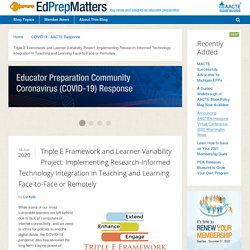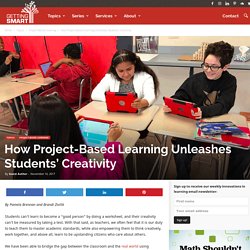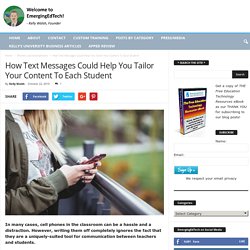

AACTE Blog Triple E Framework and Learner Variability Project: Implementing Research-Informed Technology Integration in Teaching and Learning Face-to-Face or Remotely - Ed Prep Matters. 18 Jun2020 By Liz Kolb While some of our most vulnerable learners are left behind due to lack of computers or internet connectivity, and we need to strive for policies to end the digital divide, the COVID-19 pandemic also has revealed the long-term staying power of teaching and learning in both brick-and-mortar and distance learning environments.

As a teacher educator preparing new and veteran teachers to use technology in learning, I know the magic sauce of technology integration is not found in the tool itself, rather the instructional strategies that teachers use in conjunction with the tool. 5 ways to help students develop digital literacy. It’s commonplace to be impressed when we hear of excellent test scores and educational backgrounds from top institutes, no matter the type of degree or accolades.

However, preparing our kids with test-taking strategies and admission into the best universities is not enough–and will be an extinct ideology with the changing demands of society and global economy. We need to begin preparing the next generation of learners with appropriate tools and digital literacy to thrive in the Digital Age–and this can be done even if schools are physically closed during a pandemic.
So, what should we do to ensure our kids are not operating at a disadvantage? Related content: 8 qualities of a digital literacy curriculum 5 ways to help students develop digital literacy 1. About the Author: Stephan Turnipseed is executive vice president and chief strategy officer for Pitsco Education. How Long-Term Tech Planning Pays Off—Now and In the Future. Less than a decade ago, three school districts on opposite sides of the country placed big bets on technology.

They invested heavily in infrastructure, created extensive online curricula, and funded connectivity initiatives so students could have 24/7 access to lessons. Recognizing that technology would not magically solve all of their problems, they did what so many districts fail to do, spending the time and money to train teachers to blend technology into their practice in ways that prioritized both human connection and academic rigor. When the Covid-19 pandemic forced schools to close, superintendents in the districts say the transition to remote learning was largely seamless: the day after schools shut down, most students and teachers were online together—and, importantly, knew what to do. But that was never the goal. Giving Tech a Real Seat at the Table. VIRTUAL FIELD TRIPS. Digital Citizenship in Education.
126 Bloom's Taxonomy Verbs For Digital Learning - TeachThought. By TeachThought Staff You can get a ready-for-the-classroom version of Bloom’s Digital Taxonomy for $6.95.

At TeachThought, we’re enthusiastic supporters of any learning taxonomy. (We even created our own, the TeachThought Learning Taxonomy.) Put simply, learning taxonomies help us think about how learning happens. Even if they’re ‘not good’ as we’ve often seen the DOK framework described, they still highlight that there are many ways to frame thinking and give us practice in realizing that potential. This means that we can have taxonomies for differentiation and taxonomies for thinking and taxonomies for tasks and assessment–so many possibilities for examining the actual process of thinking, learning, and the application of each. This leads to cool visuals–Bloom’s Taxonomy posters, for example. It can lead to tools that help to design lessons, units, and assessments–Bloom’s Taxonomy power verbs work well here. How Project-Based Learning Unleashes Students' Creativity. By Pamela Brennan and Brandi Zivilik Students can’t learn to become a “good person” by doing a worksheet, and their creativity can’t be measured by taking a test.

With that said, as teachers, we often feel that it is our duty to teach them to master academic standards, while also empowering them to think creatively, work together, and above all, learn to be upstanding citizens who care about others. We have been able to bridge the gap between the classroom and the real world using high-quality project-based learning (PBL).
How Text Messages Could Help You Tailor Your Content To Each Student. In many cases, cell phones in the classroom can be a hassle and a distraction.

However, writing them off completely ignores the fact that they are a uniquely-suited tool for communication between teachers and students. Used correctly, cell phones can allow teachers to tailor their lessons and content to each student’s interest and ability level without the use of special apps or internet access. It doesn’t take a smart phone to use phones smartly. Three ways that teachers can use text messaging to tailor their content to each student in classrooms where most or all of the students have access to a phone with texting capabilities include gauging student knowledge, gathering student feedback, and giving students choices. Gauge Student Knowledge Trying to get an accurate idea of what your students understand using technology is not a new idea. Many mass texting services, though, compile text responses on an online dashboard. Gather Student Feedback Give Students Options Texting As A Tool.